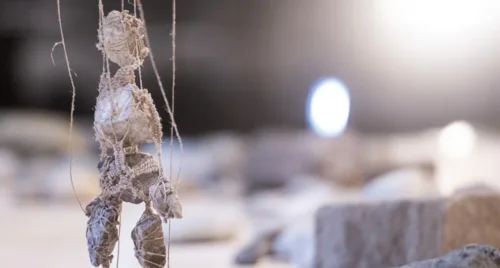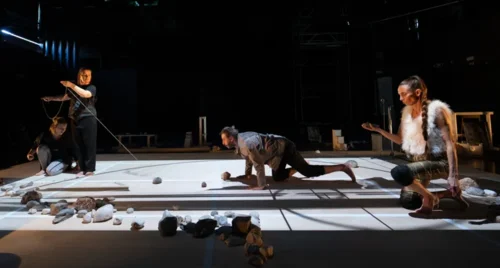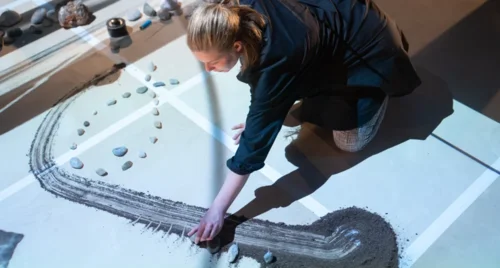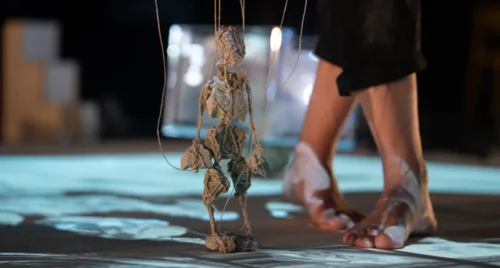The title of the performance pays homage to a short poem by Jure Detela: “Be in the stone, magical dance, / dreams have come from above, / thoughts are moving!” Though stone is normally perceived as inanimate and immobile, this performance seeks to uncover the dance within it, exploring how that dance relates to dreams and thoughts. Yet this is possible only through the movement and transformation of thoughts themselves—by “breaking through” the confines of one’s perception of self and world.
Incidentally, in one of the Ljubljana Puppet Theatre’s most iconic productions, The Little Sleepy Star, a bandit bears a stone instead of a heart, which in time transforms into a living one. By contrast, Dance in Stone seeks to reveal life within the stone itself, without the need to transform it. In this, it follows what Michelangelo Buonarroti expressed in one of his sonnets: “The greatest artist does not have any concept which a single piece of marble does not itself contain.”
Can there be thoughts in stone? Can there be emotions in stone? Can there be movement in stone? The creators of the performance explore these questions without ever breaking or damaging any stones. They are not treated as material; instead, we are invited to ask what they are telling us. A source of inspiration for the creators was how the OHO movement engaged with the world. How can one animate stone if the soul is already within it? To become co-dancers in the dance that is within the stone, we must first “unstone” ourselves—a word taken from a poem by Mak Dizdar, read aloud during the performance. As the puppeteers recognise the life within stone, they bring to life and move what was motionless within themselves, perhaps transforming petrified and deeply rooted thoughts, ideas, and principles.
A hybrid of genres, the performance features elements of postdramatic theatre, dance, object theatre, and installation, while its fundamental state of mind is rooted in poetry. It establishes various registers, from the mythically exalted to the humorous. The words that meet the stones in the performance range from the re-creation of humankind after the great flood, achieved through the casting of stones by Deucalion and Pyrrha in Ovid’s Metamorphoses, through Kafka’s interpretation of the Prometheus myth, to the poetry of Anton Aškerc, Jure Detela, and Miklavž Komelj, all while constructing a veritable palimpsest of intertextual connections. The final effect ties into the description of the mysterious stone in Pier Paolo Pasolini’s novel Petrolio: “The infinite variety of its soft colours corresponds to an infinite variety of materials, but none of them have really been identified, because each mineral presents contradictory characteristics, both in relation to itself and in relation to the other minerals with which it is amalgamated or compounded; it has not been possible to distinguish in that rock what appeared precious from what appeared to be worthless or even toxic; it has not been possible so far to determine if the analysis is impossible and the contradictions absolute /…/.”
As the performance focuses on how to develop a different relationship with stone, it also seeks to establish a new way of relating to the world. The stones in the performance are not mere objects to be reshaped at will. Each performer’s way of relating to the stone’s radical immutability, its inscrutability, or perhaps its misunderstood nature, and to its motionless constancy presents the central challenge of the piece. The stones also function as set pieces. The performers craft dynamic landscapes and symbols: barriers and obstacles to overcome, paths leading to outer and inner worlds, and bridges that connect. When the stones lift from the ground and rise into the air alongside the performers, we enter a space where the supposed laws of physics lose their authority. Here, imagination, magnetic forces, and the infinite flow between knowing and unknowing intertwine.
- Author, director and choreopgrapher:
Leja Jurišić - Author of the text:
Miklavž Komelj - Authors of used texts
Franz Kafka, Jure Detela, Anton Aškerc, Ovidij, Mia Skrbinac, Alenka Tetičkovič - Dramaturge:
Petra Veber, Leja Jurišić - Set, costume and light designer:
Petra Veber - Co-cretoars and performers:
Rok Kunaver, Gašper Malnar, Martina Maurič Lazar, Alenka Tetičkovič, Mia Skrbinac - Author of music:
Eduardo Raon - Author of video:
Atej Tutta - Advisor for animation:
Martina Maurič Lazar - Language advisor:
Irena Androjna Mencinger - Puppetry engineer:
Zoran Srdić - Stage manager and sound designer:
Damir Radončić - Producer:
Alja Mihajlović Cerar/Katra Krsmanović - Light technician:
Maša Avsec - Stage technician:
Jakob Kozelj - Warderobe:
Nataša Konić - Wrokshops manager:
Zoran Srdić - Puppet, set, props and costume production::
David Klemenčič, Olga Milić, Sandra Birjukov, Lorena Bukovec, Emma Serra Rius, Zoe Špehar, Uroš Mehle, Artiko, Pleksi izdelki Vrhovec
- We would like to thank:
Jiři Bezlaj, Ema Kugler, Andrej Detela, Marko Pogačnik
- Co-production with Pekinpah





